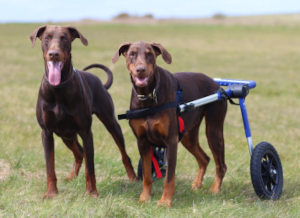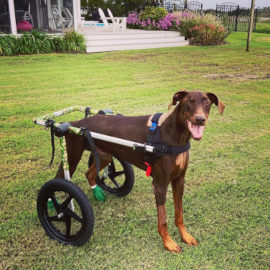6 Mobility and Health Conditions Impacting the Doberman Pinscher
By admin / March 27, 2023 / No Comments / Uncategorized
Doberman Heart Problems
Heart problems are one of the most significant health concerns for Doberman Pinschers. Unfortunately, 60% of Doberman dogs are genetically predisposed to a heart condition called dilated cardiomyopathy. Dilated cardiomyopathy is a fatal condition that causes a dog’s heart to enlarge and become too thin and weak to pump blood effectively. Unfortunately, this genetic condition can often go undiagnosed until the Doberman with DCM experiences heart failure, becomes weak, and collapses. Therefore, every Doberman should have a heart exam annually to catch the early signs of heart disease.
Wobbler Syndrome

Wobbler Syndrome is a spinal condition that causes dogs to walk with uneven, wobbly steps. Dobermans are among the most common dog breeds to get Wobbler’s Syndrome. 50% of all Wobbler’s cases occur in Doberman Pinschers. Symptoms of Wobblers in Dobermans start in middle age, around age six. Leg weakness, difficulty standing, and neck pain are usually the early signs of Wobblers.
A Doberman Wheelchair provides stability and support to keep a disabled Doberman upright. A Doberman Pinscher with Wobbler’s will likely need a full support or quad wheelchair. A dog wheelchair with four wheels will provide optimal stabilization, even with the wobbliest steps.
Eye Problems in Dobermans
Doberman Pinschers are predisposed to many eye conditions, which can lead to vision loss. For example, Progressive Retinal Atrophy, or PRA, is a genetic condition that affects the rods in a dog’s retina. As a result, the rods slowly die, which leads to worsening vision until the Doberman becomes completely blind. Although there is no cure for PRA, it has been suggested that antioxidant supplements may slow the disease progression and help pets maintain some daytime vision. Still, no clinical proof is available to show its effectiveness.
If your pet is losing its eyesight, the best thing you can do is help them adjust to its changing vision. Vision loss is disorienting for pets. By limiting furniture moves and keeping things in the same position, your pet can better adapt to new circumstances. Blind pets that walk into walls or bump their noses can benefit from a Blind Dog Halo. The halo is worn to protect them and acts as a bumper to prevent injury and alert them of nearby obstacles before they walk into them.
Intervertebral Disc Disease
IVDD is a spinal disc rupture that compresses the spinal cord and can result in mobility loss. Although more common in the dachshund or corgi, IVDD can also occur in Dobermans. The location of the disc rupture and how badly the spinal cord is affected will determine whether a dog experiences hind leg weakness or paralysis. IVDD surgery can be performed to remove the disc material, but it may take several months of rest and rehab for a dog to regain mobility. Some dogs with IVDD may never regain hind leg function.
Arthritis
Just like all big dogs, the Doberman is at risk for several joint conditions, with arthritis being one of the most common. Although senior Doberman Pinschers are prone to developing arthritis as they age, it is manageable, especially if detected early on.
Hip Dysplasia

Although hip dysplasia isn’t as common in Dobermans as in other giant dogs, around 7% of the breed has hip dysplasia. A dog can experience lameness and crippling joint pain in severe hip dysplasia cases.
Early detection is critical to keep a dog’s joints healthy. During regular veterinary visits, your vet will check your dog’s hips and watch for signs of dysplasia. Keeping your Doberman at a healthy weight and giving them daily joint supplements will help to keep their joints healthy. For mild to moderate hip dysplasia, wearing a hip brace can help the dog move around.
Von Willebrand Disease
Von Willebrand Disease is a significant health concern among Doberman Pinschers. Half of the Doberman breed are genetic carriers for Von Willebrand Disease, with 30% affected by the condition. vWD is a blood disorder where a dog’s blood doesn’t clot properly. As a result, when injured, a dog with vWD may bleed uncontrollably, quickly becoming a life-or-death emergency. Before any surgery, a Doberman Pinscher should be tested for the genetic markers of Von Willebrand to understand the risks of the procedure.
